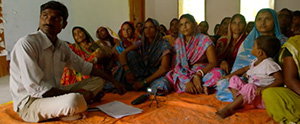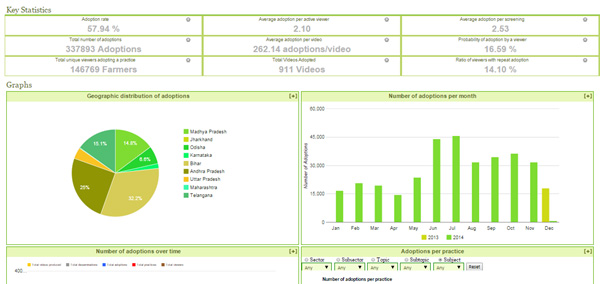The “Great SBCC Example” below was featured during the Designing the Future of Nutrition Social and Behavior Change Communication Conference and can be used as a learning aid or as an illustration of key concepts from country-level experts attending the conference.

Background
Poor farmers in low and middle income countries are often risk-averse and reluctant to adopt new methods of farming, since crop failure could potentially lead to extreme hardship. Effective agricultural extension activities can improve the uptake of new practices, leading to better outcomes for farming households. Digital Green works in eight states in India and in parts of Ethiopia, Ghana, Mozambique, Niger, and Tanzania, together with more than 20 partners. Digital Green works with local farmers to create community-led videos disseminated through local social networks to encourage farmers to adopt new practices to improve their livelihoods.
In 2012, Digital Green partnered with SPRING on a pilot study in Odisha, India, adapting their agriculture extension approach to promote maternal, infant, and young child nutrition (MIYCN) behaviors and care practices. Based on the initial success of the pilot study, Digital Green and SPRING have begun collaborating on nutrition-focused programming in Niger in 2014.1
Description of Intervention
Digital Green’s approach builds upon existing community organizations, such as a self-help group, to amplify their efforts to accelerate rural development and adoption of improved agriculture practices. This approach involves (a) participatory identification of content in which community members help identify priority practices and barriers to adoption, (b) local production of low-cost videos designed to promote uptake of priority practices, (c) group discussion using the videos as a basis for mediated instruction, where a mediator encourages participants to discuss video content, (d) follow-up home visits to support and monitor the adoption of the promoted practices, and (e) qualitative and quantitative data collection to engage communities in an iterative cycle of learning.
In 2012-2013, Digital Green and SPRING adapted this approach for a pilot program to assess the feasibility of using a similar approach to promote better MIYCN-related behaviors and care practices, including child feeding, self-care during pregnancy, and handwashing. Digital Green and local partner, VARRAT, worked with community members to produce and disseminate 10 MIYCN-focused videos in bi-weekly self-help group meetings as part of an ongoing Digital Green-VARRAT agriculture program.
Design Process
Community members designed videos to respond to locally identified challenges (“by the farmers, of the farmers, for the farmers”). Digital Green supports the creation of low-cost videos, which are produced by farmers themselves and feature local participants in rural communities across South Asia and sub-Saharan Africa. Local intermediaries then screen the videos and lead group discussions with small groups of farmers.
For the nutrition pilot, based on lessons learned from the agricultural community video extension programs, Digital Green applied the central principles of flexibility, attention to local context, and leveraging of local networks.
Design Strategy
- Local farmers identify learning objectives: To be effective, agricultural extension programs need to adapt messaging to the varying needs of farmers operating in different contexts, taking into account, for example, soil quality, access to water, language, or farmer capabilities. To ensure the most appropriate, effective content, the local farmers take ownership of the process.
- Social networks are used to connect community members with experts: The excitement of appearing on video motivates them to participate, and similarities are leveraged to minimize the distance between teacher and learner.
A similar process was used in Digital Green’s nutrition pilot study.
Implementation Strategies
- Ensure continuous capture, review, and analysis of nearly real-time operational data. Digital Green used its innovative, multidirectional system, Connect Online Connect Offline (COCO), to support these functions (Figure 1).
- Enable rapid diagnosis of and attention to problems in implementation by using low-cost information and communication technologies customized to low-resource settings with intermittent internet connectivity. These features of COCO help promote higher adoption of good practices in addition to the system’s data gathering and analysis function.
- Achieve deeper insights into intervention performance through periodic bottleneck analysis, cost-effectiveness studies, case studies, third-party quality assurance surveys, baseline and endline studies, and randomized control trials.
Figure 1. Sample Digital Green COCO Report

Evidence of Effectiveness
Digital Green has produced more than 3,500 videos2 in more than 28 languages and reached over 500,000 farmers in 6,500 villages. A controlled evaluation demonstrated the approach to be 10 times more cost-effective and the uptake of new practices seven times higher compared to traditional extension services. In a 13-month trial involving 16 villages (eight control and eight target villages balanced for parameters such as size and mix of crops) and 1,470 households, Digital Green increased the adoption of certain agricultural practices sevenfold over that of a classic training and visit–based extension approach.
In a 13-month study involving 16 villages in India, the Digital Green approach was shown to be 10 times more effective per dollar spent than a classical extension system, on a cost-per-adoption basis.3
For Digital Green and SPRING’s pilot feasibility study this approach was adapted to promote MIYCN–related behaviors and care practices such as child feeding, care during pregnancy, and handwashing. Process and uptake-related evaluations were highly encouraging. Among targeted mothers, demand and acceptability were strong and knowledge of some of the nutrition messages was high. Although the pilot was not designed to measure behavior change, the findings indicated that community members were trying some behaviors promoted in the video.
Key Takeaways for Nutrition Social and Behavior Change Communication
- Keep program design flexible and adaptable; regularly and rapidly review data to inform continuous improvement.
- Focus on localized interventions; for faster implementation and greater community buy-in, integrate intervention into existing structures.
- Customize technological components for low-resource contexts.
- Refine and use standard process and impact indicators in a way that is feasible to use at scale.
- Develop, test, evaluate, and refine the application of information and communication technology as well as participatory methodologies.
Organization: Digital Green
Digital Green is a not-for-profit international development organization that uses an innovative digital platform for community engagement to improve livelihoods in rural communities across South Asia and sub-Saharan Africa. They partner with local public, private, and civil society organizations to share knowledge on improved agricultural practices, livelihoods, health, and nutrition, using locally produced videos and human-mediated dissemination.